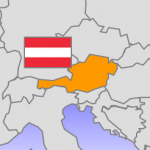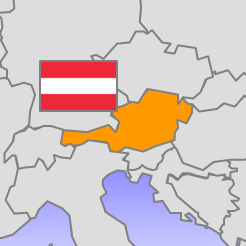Carolina Plescia and Sylvia Kritzinger

Introduction
Austria went to the polls on Sunday, May 25th to elect 18 members of the European Parliament, one less than in 2009 due to the EU membership of Croatia. The electoral system used for the European elections is the same as for the national elections but instead of 39 constituencies there is only a single national constituency. The electoral system is a proportional system with a threshold of 4% and the possibility for the voters to express a preference vote for a single candidate, a possibility that has been rarely used by Austrians (Müller et al. 2001). Finally, Austria is still the only country in Europe where citizens can vote at the age of 16 in nationwide elections.
The election campaign
Beside the two main parties that have dominated Austrian politics over the last decades, the Social Democratic Party of Austria (SPÖ) and the Austrian People’s Party (ÖVP), both currently forming a grand coalition, voters found three other well-known parties on the electoral ballot: two EU-skeptic parties, the Freedom Party of Austria (FPÖ) and the Alliance of the Future of Austria (BZÖ) and the pro-European party, The Greens (Grüne). Alongside these parties, four new parties contested the European elections for the first time: the pro-European The New Austria (NEOS) and three EU-skeptic parties, Another Europe (Europe-Anders), The Reform Conservatives (REKOS) and the EU-Stop. The big winner of the European elections in 2004 and 2009, the EU-critical List Hans-Peter Martin (List HPM), decided not to run in this election, and in fact disappeared from the Austrian political scene. Another notable absent is the Team Stronach, which ran for the first time in the national elections in September 2013 gaining 5.7% of the vote share.
| Carolina Plescia is Assistant Professor at the Department of Methods in the Social Sciences, University of Vienna. She obtained a PhD in Political Science and Quantitative Methods from Trinity College Dublin, Ireland in 2013. Her main research interests include comparative electoral behavior, coalition governments, and research methodologies. Sylvia Kritzinger is Professor and Head of the Department of Methods in the Social Sciences, University of Vienna. She holds a PhD in Political Science and is one of the principal investigators of the Austrian National Election Study. Her research focuses on electoral behavior, public opinion formation, democratic representation, and empirical methods. |
While it was quite clear before the election that only the parties currently represented in the Austrian Parliament (SPÖ, ÖVP, FPÖ, Grüne, NEOS) would get enough votes to send their representatives to Strasbourg, a series of political scandals that hit the two government parties, SPÖ and ÖVP, made the exact election outcome less predictable. The electoral campaign was in general characterized by a pervasive sense of disappointment with how the European Union has addressed the financial and economic crisis without taking into account the social repercussions of its austerity policies, furthermore, it focused on the increases of prices attributed to the euro, the alleged excessive bureaucratization of the apparatus in Brussels and immigration. The anti-European campaign of the FPÖ focused exactly on this sense of disappointment with the EU. Meanwhile, the other parties focused their campaigns more on policies they will pursue in the European Parliament, if elected.
The results
Out of nearly 6.5 million voters, less than half turned out to vote: approximately 45.4% against 46.0% in 2009; this is a rather low percentage when considering that the turnout in national elections in Austria is generally very high (75% in 2013), although, it has been decreasing in recent years.
Pre-electoral expectations about the electoral results have been all confirmed: only parties represented in the Austrian Parliament today have managed to overcome the 4% threshold. Also, the two ruling parties were able again to retain the majority of the votes, though narrowly.
| Table 1 – Results of the 2014 European elections – Austria | ||||||
| Party |
EP Group |
Votes (%) |
Seats |
Votes (change from 2009) |
Seats (change from 2009) |
|
| Austrian People’s Party (ÖVP) |
EPP |
27.0 |
5 |
-3.0 |
-1 |
|
| Social Democratic Party of Austria (SPÖ) |
S&D |
24.1 |
5 |
+0.4 |
+0 |
|
| Freedom Party of Austria (FPÖ) |
NI |
19.7 |
4 |
+7.0 |
+2 |
|
| The Greens (Grüne) |
G-EFA |
14.5 |
3 |
+4.6 |
+1 |
|
| Alliance of the Future of Austria (BZÖ) |
NI |
0.5 |
0 |
-4.1 |
-1 |
|
| The New Austria (NEOS) |
ALDE |
8.1 |
1 |
– |
– |
|
| The Reform Conservatives (REKOS) |
NI |
1.2 |
0 |
– |
– |
|
| Another Europe (ANDERS) |
NI |
2.1 |
0 |
– |
– |
|
| EU-STOP |
2.8 |
0 |
– |
– |
||
| Others |
0.0 |
0 |
– |
– |
||
| Total |
100 |
18 |
||||
| Turnout (%) |
45.4 |
-0.6 |
||||
| Legal threshold for obtaining MEPs (%) |
4% |
|||||
| Source: https://www.bmi.gv.at/cms/BMI_wahlen/europawahl/2014/Wahlkarten.asx | ||||||
| EP group abbreviations: EPP=European People’s Party; S&D=Progressive Alliance of Socialists and Democrats; ALDE=Alliance of Liberals and Democrats for Europe; G-EFA=The Greens–European Free Alliance; ECR=European Conservatives and Reformists; GUE-NGL=European United Left–Nordic Green Left; EFD=Europe of Freedom and Democracy; NI=Non-Inscrits. | ||||||
The ÖVP defends its electoral record confirming itself as the first party in the European elections with 27% of the vote; however, the party loses 3 percentage points and one seat compared to the previous European elections. Despite this, the ÖVP claims victory, having actually gained 3 percentage points compared to the national elections in September 2013. The SPÖ gets 24.1% of the vote, improving its performance slightly compared to the last European elections when it obtained 23.7% of the votes.
The FPÖ earns many votes compared to 2009 (19.7% of the vote, + 7 percentage points), doubling its seats (2 to 4 seats). Notwithstanding this, the FPÖ fails to match, albeit slightly, the result of the last national elections when this party got 20.5% of the vote share.
The Greens party confirms itself fourth party in Austria increasing its vote share by 4.6 percentage points from the previous European elections. The very good performance of the Greens is surprising in light of the fact that pre-election polls gave the Greens only a tiny advantage over the NEOS. Instead, the Greens surpass the NEOS by 6 percentage points. Meanwhile, the NEOS party, that has contested the European elections for the first time, obtains a good 8% of the vote and an important seat in the European Parliament. This result helps the NEOS to establish itself as a strong and viable party.
No other party is able to obtain seats. It should be noted in this regard that the BZÖ is almost disappearing from the Austrian political scene; the party loses 3 percentage points when compared to the last national election and 4.1 percentage points since the last European elections in 2009. The replacement of the well-known leading candidate – the daughter of the famous Jörg Haider, Ulrike Haider-Quercia – with a little-known candidate during the election campaign certainly did not help the BZÖ. Also, the other EU-skeptic parties were not able to pass the 4% electoral threshold. Despite this, the performance of the EU-Stop party deserves to be mentioned: the party, in fact, obtains a significant 2.8% of the vote share. It called for a referendum to leave the EU, a return to the Austrian former currency, the Schilling, and the introduction of a Swiss-style direct democracy.
Discussion of the results
Two considerations deserve attention. First, the pro-European parties have won the 2014 European elections in Austria. These parties have in fact obtained almost 75% of the total vote share. Second, in spite of the fact that all parties consider themselves winners of these European elections, their performances appear less impressive if one takes into account that 18% of the votes of the List HPM were ‘freely available’ on the electoral market.
The two mainstream parties were able to stop, to a certain extent, the electoral losses they continuously experienced over the last years. However, the result of the SPÖ hides that the party leaders have chosen the wrong leading candidate: Eugen Freund is a famous TV journalist but with no experience in politics and moreover, not a party member of the SPÖ. This choice had repercussions on the electoral campaign at the local level with party members not canvassing as strongly as necessary for their party. The party leadership was also more concerned with national issues, such as the budget for the next two years, rather than the electoral campaign. Concerning the ÖVP, its leading candidate Otmar Karas was probably the reason why the party did not lose more votes and remained the strongest party in the European elections. Karas’ long experience and competence at the EU level surely paid off at the polls, with the national party contributing very little to his success.
The Eurosceptic party FPÖ rightly claims victory, but its alleged success is below expectations if one considers that some pre-election polls predicted that the FPÖ would become the first party in Austria, surpassing both the SPÖ and the ÖVP, which it however failed to do. In addition, considering that the EU-critical List HPM did not run for the 2014 elections, the success of the FPÖ is even much less obvious. It appears as if the FPÖ failed to mobilize EU-skeptical voters in general and the Euro-critical HPM-voters in particular.
Thus, in the end, only the success of the Greens and NEOS can be labelled as clear electoral victories: these two parties were particularly successful amongst the young, urban and well-educated voters with a strong pro-European attitude. These two parties focused their electoral campaign on European issues that appear to be increasingly important to Austrian citizens, at least to those who turned out to vote.
Finally, with regard to the Austrian experience with the European elections considering the level of turnout, the country surely follows the model of the second-order national elections (Reif and Schmitt, 1980): the participation rate is always much lower than the national average. Still, the performances of the two government parties, the ÖVP and the SPÖ, and the opposition parties do not follow unambiguously the second-order elections model. In detail, while the SPÖ is often punished by voters in the European elections (except in the 2014 election), the ÖVP almost always performs better during the European elections. Opposition parties have never gained vote shares when compared to national elections, but the 2014 European elections indicate that this trend might be reversing.
Conclusions
Broadly speaking, one of the central issues of these European elections in Austria has been whether and to what extent the two mainstream parties would have been able to gain yet again an absolute majority of the votes. In fact, many wanted to see if there would have been a massive shift of the votes towards the FPÖ. The two ruling parties have been able to hold, and these European elections send a strong message to all pro-EU parties. Despite this, considering that many Euro-skeptic voters seem to have remained at home this time, only the next election will determine whether Europe is considered by Austrians the future or a threat.
References
Müller, W. C., Jenny, M., Steininger, B., Dolezal, M., Philipp, W., Preisl-Westphal, S. (2001), Die österreichischen Abgeordneten, Schriftreihe des Instituts für angewandte Politikforschung, vol. 23. Wien, Facultas.
Reif, K. and Schmitt, H. (1980), Nine Second Order National Elections: A Conceptual Framework for the Analysis of European Election Results, in “European Journal of Political Research”, vol. 8, pp. 3-44.
